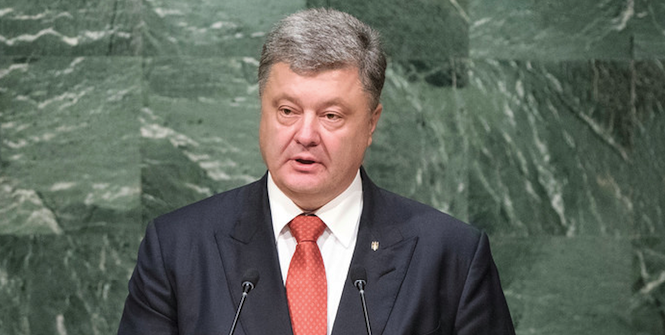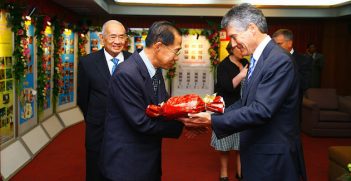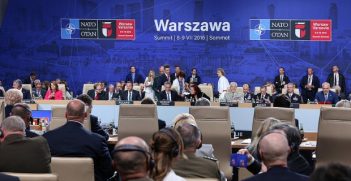War or Peace in Ukraine?

The conflict in Ukraine has reached an uneasy impasse. As Putin, ever the strategic grandmaster, focuses his attention on the Middle East the future of peace in Ukraine remains uncertain.
With all remaining quiet in the East of the country, where the conflict had sent ripples of Russian expansionist paranoia throughout Europe, what is the current status of the war in Ukraine?
By all appearances, the battle lines remain firmly in place. Using the world stage of the UN General Assembly, President Poroshenko steadfastly defended Ukrainian sovereignty in September to lambast Putin and stress that the war ‘is neither a civil war [and] not an internal conflict’. Prime Minister Yatsenyuk used his New Year speech primarily to address the growing disillusionment with the Ukrainian political process, as well as the free trade agreement with the EU. Throughout his end of year speeches to press and parliament, Yatsenyuk made numerous mention of historical ‘Russian chauvinism’ and the ‘unreasonable’ grounds of lifting sanctions against Russia. Yatsenyuk stressed Ukraine’s adherence to the Minsk agreement; by contrast ‘Russia has never done anything’.
On the Ukrainian front, it would appear that nothing has changed in the political arena, while the government struggles to push through reform in an effort to fulfil Euromaidan promises. Ukrainian foreign policy persists in efforts for greater EU integration and NATO membership. So long as Ukraine believes that Russia continues to meddle in the country’s internal affairs there is likely to be little easing of anti-Russian sentiment. While the damage done to Ukrainian-Russian relations may well be irreparable, diplomatic mitigation may at least ease some tension. Ukraine so far does not have the diplomatic will to do so.
The story remains the same for Russia. Until President Putin’s annual press conference in December last year, Putin had categorically denied any Russian soldier involvement in Ukraine. He did, however, make an uncharacteristic omission saying that ‘Russian military personnel were in Ukraine’, but added that it ‘doesn’t mean there are regular Russian forces there. Feel the difference’. Although Putin merely skimmed over this omission, his first official statement that Russia has played a role in the Ukrainian conflict is a demonstration of his self-confidence.
As the West loses interest and patience in a Ukrainian conflict that has no foreseeable end, Putin has created yet another frozen conflict in Russia’s near abroad. This is a strategy Putin has used to great effect in Transnistria, Abkhazia and South Ossetia in what Clausewitz would call a ‘culminating point’. When Russian forces make a military incursion, the intention is not necessarily to win but to destabilise the infiltrated country so that it yields to Russian will when the military advance has reached a standstill. The subversion of Ukrainian self-determination in the wake of Euromaidan and downfall of former President Yanukovych was successful, until it reached a culmination point.
This is where the conflict currently stands. Russia’s military incursion into Ukraine was short, sharp and effective but Putin – as in Georgia and Moldova – cannot afford a protracted war. A frozen conflict achieves Putin’s aim of politically destabilising Ukraine and derailing its road to liberal reform. This is something Russia could not tolerate and it clutches onto Ukraine as a buffer state for geo-strategic interests.
Today, despite a significant reduction in conflict, hostilities remain in Ukraine. A UN report released in November, 2015 found that:
The absence of effective control of the Government of Ukraine over considerable parts of the border with the Russian Federation (in certain areas of Donetsk and Luhansk regions) continued to facilitate an inflow of ammunitions, weaponry and fighters from the Russian Federation to the territories controlled by the armed groups, which carries latent risks of a resurgence of hostilities.
On the matter of human rights, the UN reports that there remains approximately 1.7 million internally displaced Ukrainians within the country. Similarly, the Organisation for Security and Co-operation in Europe has released numerous Special Monitoring Mission reports in the New Year. The latest report from 5 February observed ‘a significant number of ceasefire violations in Donetsk region and several in Luhansk region’. The Ukrainian Ministry of Defence’s most recent news report on 5 February claims that ‘the enemy violated the ceasefire for 81 times over the past 24 hours’. The report alleges that grenade launchers, heavy machine guns, small arms and mortars were used by ‘Kremlin bandits’ and ‘terrorists’ on Ukrainian government forces.
The non-observance of the Minsk 2 agreement from both sides continues to allow for open hostilities. If there is no demonstrated commitment to absolute peace, there remains the possibility of a return to full-fledged war. Although a return to all-out war is something both sides cannot afford, Russian-backed separatist forces are unlikely to relinquish anymore lost territory without a fight. The implementation of the Minsk 2 agreement needs to be followed by both sides and a political settlement must be made between the Russian and Ukrainian governments.
Putin needs to be convinced of leaving Ukraine without appearing to lose face. The problem is that Putin needs assurance that Ukraine will not fully integrate into the EU or join NATO – something that Euromaidan supporters and Poroshenko have risked everything for, and paid for dearly. With Poroshenko’s job approval rating sitting at 17 percent, his legitimacy hinges on his capacity to implement reform and end the conflict in the East of the country. If not, he is seen to be no better than Yanukovych – and the last thing Ukraine needs right now is a return to the political turmoil witnessed in 2014.
Ukraine continues to need Western support to end a frozen conflict manufactured by Putin, who currently has no intention of dismantling it. Whilst sanctions have been effective in pressuring the Kremlin to the current impasse, so long as Russian boots remain within the territory of Ukraine, 2016 will shape up to be another quiet year of war but a war nonetheless.
Reid Hutchins is a Master of Strategic Studies student at the Australian National University. This article may be republished with attribution under a Creative Commons Licence.





